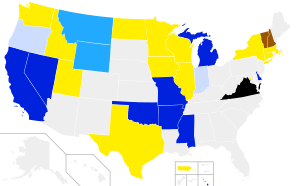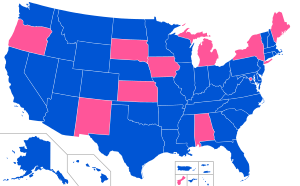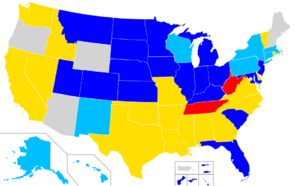Governor (United States) facts for kids
In the United States, a governor is the main leader of each of the fifty states and five territories. They are like the chief executive and commander of the state's forces. A governor acts as both the head of state (representing the state) and the head of government (running the state's daily business).
Governors have important powers. They oversee the state's government, suggest and sign laws, or even reject them (veto). They can also pardon people for state crimes. Governors are responsible for making sure state laws are followed. They also lead the state's executive branch. Governors use tools like executive orders and budgets to guide the state. They work with department heads, many of whom they choose. Most governors can also appoint state court judges from a list of candidates.
Almost all states and territories have a lieutenant governor. These are Arizona, Maine, New Hampshire, Oregon, Puerto Rico, and Wyoming. The lieutenant governor takes over if the governor leaves office due to impeachment, death, or resignation. Lieutenant governors also act as governor if the main governor is temporarily unable to do their job. They often lead the upper house of the state legislature. In this role, they usually cannot join debates or vote unless there's a tie.
Contents
What a Governor Does
States in the U.S. share power with the federal government. They have many rights under the U.S. Constitution. These include managing trade within the state, holding elections, and creating local governments. Each state has its own constitution and government. This government has three parts: the executive (led by the governor), the legislative (lawmakers), and the judicial (courts).
The governor leads the executive part of the government in each state or territory. They can control the state's budget and choose many officials, including some judges. The governor also leads the state's National Guard when it's not called up by the federal government. They also lead the state's defense force. In many states, the governor can also reduce or cancel a criminal sentence. Most U.S. governors serve four-year terms. Only governors in New Hampshire and Vermont serve two-year terms.
All U.S. governors are chosen by direct election. They have a lot of power, but this power can be limited by the state legislature. Other elected officials can also balance the governor's power. Governors can veto state bills. In most states, they can also use a line-item veto on spending bills. This means they can reject specific parts of a bill without rejecting the whole thing. State lawmakers can sometimes overrule a governor's veto with a special vote.
In some states like Alabama, Indiana, Kentucky, and Tennessee, a simple majority vote can overrule a governor's veto. In Arkansas, a larger majority is needed. The governor of North Carolina did not have veto power until 1996. In most states, if a state's U.S. Senate seat becomes empty, the governor can appoint someone to fill it until a special election. Governors of Oregon, Alaska, and Wisconsin do not have this power.
A state governor often gives an annual State of the State address. This speech tells everyone about the state's condition. Governors also do ceremonial things. They greet important visitors, give out state awards, and attend events like the state fair. Many governors also have an official residence, often called the Governor's Mansion.
Experts study how powerful governors are. They look at "personal powers" (like how many votes they won) and "institutional powers" (like their control over the budget or veto power).
History of Governors
In the early days of North America, governors were chosen in different ways. In colonies ruled by Great Britain, France, or Spain, the king or queen chose the governor. In colonies with special charters, like Connecticut Colony, people elected their own governors. In proprietary colonies, like the Province of Carolina, the owners of the colony chose the governor.
During the American Revolutionary War, most of the Thirteen Colonies removed their royal governors. Some colonies, like Connecticut and Rhode Island, already elected their governors.
Before states became states, many were territories. The U.S. president appointed their governors. This changed over time. Puerto Rico started electing its governor in 1948. The last appointed territorial governor left office in 1978.
Who Are the Governors?
Political Parties
As of July 2025, there are 27 states with a Republican governor. There are 23 states with a Democratic governor. Among the territories, there are four Democrats, one Independent, and one New Progressive governor. No independent or third-party candidates currently lead a state.
How Long They Serve
Most governors serve four-year terms. The only exceptions are Vermont and New Hampshire, where terms are two years long.
The current longest-serving governor is Greg Abbott of Texas. He was re-elected for his third term in 2022.
The longest-serving governor ever was Terry Branstad of Iowa. He served for 22 years. He left office in 2017 to become the U.S. Ambassador to China. He broke the record held by George Clinton of New York.
Most states and territories have term limits. These laws officially limit how long a governor can serve.
Age of Governors
The oldest current state governor is Kay Ivey of Alabama, born in 1944. The youngest current state governor is Sarah Huckabee Sanders of Arkansas, born in 1982. Among territorial governors, Lou Leon Guerrero of Guam, born in 1950, is the oldest. Jenniffer González-Colón of Puerto Rico, born in 1976, is the youngest.
The youngest person to ever be a governor was Stevens T. Mason of the Michigan Territory. He was elected in 1835 at age 24. He later became Michigan's first state governor at age 25.
Most states require a governor to be at least 30 years old. Some states have lower age limits, like 25, 21, or 18. Oklahoma is the only state that requires governors to be at least 31 years old. Some states just require the governor to be a registered voter, which means they must be at least 18.
Gender of Governors
As of July 2025, there are 38 male state governors and 12 female governors. The female governors are: Kay Ivey (Alabama), Katie Hobbs (Arizona), Sarah Huckabee Sanders (Arkansas), Kim Reynolds (Iowa), Laura Kelly (Kansas), Janet Mills (Maine), Maura Healey (Massachusetts), Gretchen Whitmer (Michigan), Kelly Ayotte (New Hampshire), Michelle Lujan Grisham (New Mexico), Kathy Hochul (New York), and Tina Kotek (Oregon).
Four territorial governors are male. One territorial governor and the mayor of Washington, D.C. are female.
A total of 43 women have served as state or territorial governors.
The first female governor was Nellie Tayloe Ross of Wyoming. She was elected in 1924 and took office in 1925. Miriam A. Ferguson of Texas was also elected in 1924 and took office shortly after. Both were wives or widows of former governors. The first female governor elected without being related to a past governor was Ella T. Grasso of Connecticut, elected in 1974.
Connecticut, Arizona, and New Mexico are the only states to have elected female governors from both major political parties. Arizona was the first state where one woman governor was followed by another woman governor. Arizona has had the most female governors, with five in total.
LGBTQ Status
Currently, three governors are openly from the LGBTQ community. They are Jared Polis (Colorado), who is gay, and Tina Kotek (Oregon) and Maura Healey (Massachusetts), who are lesbians.
Race and Ethnicity
Most state governors are non-Hispanic white. As of July 2025, there are three minority governors. They are Wes Moore of Maryland, who is Black, Michelle Lujan Grisham of New Mexico, who is of Hispanic descent, and Kevin Stitt of Oklahoma, who is a member of the Cherokee Nation.
Among the five U.S. territories, there is one Hispanic governor, one Black governor, and three Pacific Islander Americans serving as governor. The mayor of Washington, D.C., Muriel Bowser, is African-American.
In 1990, Douglas Wilder of Virginia became the first African-American governor of any state since the Reconstruction era.
Birthplace
Sixteen current state governors were born outside the state they lead. One governor, Joe Lombardo of Nevada, was born outside the United States (in Japan).
State constitutions have different rules for how long a governor must have lived in the state or been a U.S. citizen. Unlike the President, state governors do not need to be born in the U.S.
Physical Disability
Two governors who were legally blind have served: Bob C. Riley (Arkansas) and David Paterson (New York).
The current governor of Texas, Greg Abbott, has used a wheelchair since an accident in 1984. Governor of New York Franklin D. Roosevelt also used a wheelchair and later became the first president to do so. Governor of Alabama George Wallace was paralyzed after being shot in 1972.
Governor's Salary
In 2009, the average salary for a state governor was about $124,398. The highest salary currently accepted is that of New York Governor Kathy Hochul at $225,000. The lowest salaries are for Maine Governor Janet Mills and Pedro Pierluisi of Puerto Rico, both at $70,000.
Some governors have refused their salary or taken only $1.00 per year. For example, Alabama Governor Robert J. Bentley refused his salary until the state reached full employment. Michigan Governor Rick Snyder took $1.00 per year. Texas Governor Greg Abbott has returned his salary to the state every year. Arnold Schwarzenegger, when he was Governor of California, also did not accept his salary. Other governors have taken a pay cut.
In many states, the governor is not the highest-paid state employee. Often, the head football or men's basketball coach at a major state university earns more.
When Governors Are Elected
All states except Louisiana hold gubernatorial elections on the first Tuesday after the first Monday in November. This means the election can be as early as November 2 or as late as November 8. Louisiana has a different system.
- Two states hold their gubernatorial elections every even-numbered year: New Hampshire and Vermont.
- 34 states and 3 territories hold their elections during a midterm election year (when there is no presidential election).
- 9 states and 2 territories hold their elections during a presidential election year.
- 3 states hold their elections the year before a presidential election year: Kentucky, Louisiana, and Mississippi.
- 2 states hold their elections the year after a presidential election year: New Jersey and Virginia.
How Governors Are Chosen (Primaries)
Most states hold primary elections. In a primary, each political party chooses its candidate. The winners then run in the general election. In California, Louisiana, and Washington, all candidates run together in one primary. The top two candidates, no matter their party, move on to the general election.
Term Limits for Governors
- Further information: Term limits in the United States#Gubernatorial term limits
In most states, governors can serve two four-year terms.
Governor and Lieutenant Governor
The relationship between the governor and lieutenant governor varies a lot by state. In some states, they are chosen separately. In others, the governor candidate chooses their lieutenant governor candidate before the election.
- Five states do not have a lieutenant governor. If the governor's office becomes empty, a different state official takes over. These states are Arizona, Oregon, Wyoming, Maine, and New Hampshire.
- Two states have the State Senate appoint the lieutenant governor. This means they might be from different political parties than the governor. These states are Tennessee and West Virginia.
- Seventeen states have separate elections for governor and lieutenant governor. This can lead to them being from different political parties.
- Eight states have the governor and lieutenant governor run together on the same ticket. However, the governor does not choose their running mate. Instead, primaries for each role are held separately. The winners then run together in the general election.
- Nineteen states have the governor and lieutenant governor run together on the same ticket. In these states, the governor candidate gets to choose their running mate, similar to the President and Vice President.
Rules to Become Governor
Most states have rules in their constitution about who can be governor. These rules usually cover age, how long someone has lived in the state, and U.S. citizenship. For example, many states require a governor to be at least 30 years old. They also often require the person to have lived in the state for a certain number of years.
See also
 In Spanish: Gobernador (Estados Unidos) para niños
In Spanish: Gobernador (Estados Unidos) para niños
- The flags and seals of governors of the U.S. states
- Gubernatorial lines of succession in the United States
- Governor and lieutenant governor (non-U.S.)
- List of U.S. state governors born outside the United States





